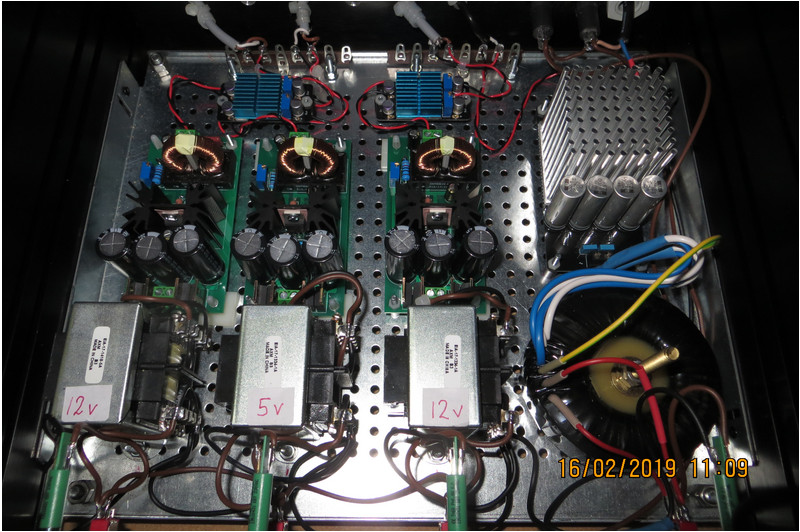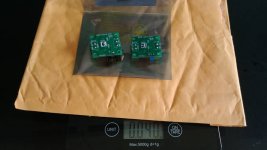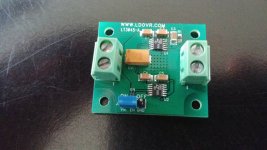sq225917, absolutely.
I've measured many transformers of the same type - the tolerance regarding necessary resistor is negligible.
So yes, one snubber for each transformer type. Having different transformers, individual resistors are necessary.
Looks like it's not my day in respect to exact statements today
I've measured many transformers of the same type - the tolerance regarding necessary resistor is negligible.
So yes, one snubber for each transformer type. Having different transformers, individual resistors are necessary.
Looks like it's not my day in respect to exact statements today
Hello DIY fellows
Sorry if this is a very dumb question. But what does the abbreviation HPULN mean. The
abbreviation HPULN was first mentioned in this thread in post 34 from Stammheim but no explanation what it means. Does it mean High Power Ultra Low Noise?
Kind Regards
Phil
Sorry if this is a very dumb question. But what does the abbreviation HPULN mean. The
abbreviation HPULN was first mentioned in this thread in post 34 from Stammheim but no explanation what it means. Does it mean High Power Ultra Low Noise?
Kind Regards
Phil
Hi.
Just finished my build, I have regulator on my Switch, 2 Dacs and my PC.
I have been listening on it for one week, and I can say the LT3045 regulators make a huge difference in my setup. Before I was quite happy with my LD1084V but the LT3045 is just way way better.
Now I can easily justify the price, as it brings so much more pleasure listening to my Dacs. I have a Topping D50 and a Chord 2Qute both perform way better with these Lt3045.

Best Regards
Michael
Just finished my build, I have regulator on my Switch, 2 Dacs and my PC.
I have been listening on it for one week, and I can say the LT3045 regulators make a huge difference in my setup. Before I was quite happy with my LD1084V but the LT3045 is just way way better.
Now I can easily justify the price, as it brings so much more pleasure listening to my Dacs. I have a Topping D50 and a Chord 2Qute both perform way better with these Lt3045.

Best Regards
Michael
... I can say the LT3045 regulators make a huge difference in my setup. Before I was quite happy with my LD1084V but the LT3045 is just way way better.
Michael
Very nice build. Thanks for the reaffirmation that the (Stammheim) LT3045 regulator boards are excellent. Should be so given the much better noise and PSRR figures of the LT3045 vs the LD1084, especially since the 1084 tops out quickly above 10kHz or so.
What are the various pieces in your build?
Den
Very nice build. Thanks for the reaffirmation that the (Stammheim) LT3045 regulator boards are excellent. Should be so given the much better noise and PSRR figures of the LT3045 vs the LD1084, especially since the 1084 tops out quickly above 10kHz or so.
What are the various pieces in your build?
Den
3 Times split bobbin Trafos + 3 Times LD1084V + a lot of mpaudio LT3045.. Best improvement on my Digital Setup ever.
3 Times split bobbin Trafos + 3 Times LD1084V + a lot of mpaudio LT3045.. Best improvement on my Digital Setup ever.
So you added a large format HPLUN for the new toroid trafo, and added 2 small format HPLUN to the back of two LD1084 rails?
So you added a large format HPLUN for the new toroid trafo, and added 2 small format HPLUN to the back of two LD1084 rails?
Yes, I'm powering my Switch (12v/4.7 watt), my amp Dac1 (5v/4.2 watt), my Dac2 (12v/6.8watt) from the two small HPLUN.
The PC is toroid and large 5 amp 12 volt HPLUN.
Playing right now, and I'm so happy with the sound. It really gave me a great step up in sound quality on both my Dac's.
The expensive investment in LT3045 is really worth it.
My suggestion is if you're on a tighter budget and would like to try them out, do a good LPS and try the smaller 1.5 amp HPLUN and decide yourself..
Best Regards Michael
Hi
Would the LT3045 /3094 have a problem or a significant drop in performance if there are four 560uF SANYO OS-CONs on the PCB behind it?
https://hr.mouser.com/datasheet/2/315/AAB8000C247-1131709.pdf
Would the LT3045 /3094 have a problem or a significant drop in performance if there are four 560uF SANYO OS-CONs on the PCB behind it?
https://hr.mouser.com/datasheet/2/315/AAB8000C247-1131709.pdf
HiHi grunf,
Sorry, I don't understand your question, as there are 2 capacitors behind the reg's on each HPULN power supply PCB...
Why are you thinking about that question?
Best regards
Stammheim
I would use the LT3045 / 3094 reg for my DAC, but there are already four 560uF os-con on the PCB on +/- 5V power supply. So behind the LT regulator
Hi grunf,
Sorry for late response, I didn't get any "new message notification".
One shouldn't have problems with more capacitance, then the present onboard-capacitance. Further you will have some resistance between the HPULN's out and your caps...
Nevertheless, each circuit is different - so it's about trying it out. You can order a HPULN without those output caps, if you feel better with it.
Best regards
Stammheim
Sorry for late response, I didn't get any "new message notification".
One shouldn't have problems with more capacitance, then the present onboard-capacitance. Further you will have some resistance between the HPULN's out and your caps...
Nevertheless, each circuit is different - so it's about trying it out. You can order a HPULN without those output caps, if you feel better with it.
Best regards
Stammheim
Since I recently acquired one of such PSU's (single voltage 3A version) I can tell that less capacitance is indeed better. In original form an old simple LDO design I made years ago performed better (subjectively). Time is very limited these days but I think more experimentation with smaller value output caps is necessary. 2 x 390 µF 20V OS-CON in parallel might not be the best choice. Well, it simply isn't.
Last edited:
The spirits are divorced regarding output capacitance by a very (very) small count of users. There are people adding or subtracting capacitance, feedbacking an improvement.
All feedbacks - including yours - describe a subjective improvement - So from my impression it's like using different caps or other mods, which also can cause several impressions to auditors.
What would be interesting is to know, what exactly you perceive as "better", in one setup or several setups, and if other auditors also felt music sounding "better".
Best regards
Stammheim
All feedbacks - including yours - describe a subjective improvement - So from my impression it's like using different caps or other mods, which also can cause several impressions to auditors.
What would be interesting is to know, what exactly you perceive as "better", in one setup or several setups, and if other auditors also felt music sounding "better".
Best regards
Stammheim
I agree about less capacitance on the output of LT304x regs.
I built a small LPSU with R-core, Schottky diodes, a LT1963, then an (ldovr) 1A LT3045, then another LT3045 in series, for a 3 stage regulator producing 7.1V @ 1 A.
In the initial build I added 2 Kemet 560mfd Alu polymer caps to the output of both LT3045's. I then conducted a long burn in and listening test (>2 weeks). I heard something clearly and consistently wrong with the sound. Then I went back in and removed all the Kemet caps. The bad sound vanished and I was finally very happy with the sound of my new LPSU, which powers my UTA Regan in the most critical part of the signal path, that is just before the DAC !
(I added the excess Kemets to the output of a clone Sigma 11 regulator LPSU, which seemed to like them just fine, sweetening up their sound a nice little bit )
)
The last couple of pages of this DIYAudio thread
goes into this question with discussion of the spec sheets and different applications. I recommend checking it out.
Dave
I built a small LPSU with R-core, Schottky diodes, a LT1963, then an (ldovr) 1A LT3045, then another LT3045 in series, for a 3 stage regulator producing 7.1V @ 1 A.
In the initial build I added 2 Kemet 560mfd Alu polymer caps to the output of both LT3045's. I then conducted a long burn in and listening test (>2 weeks). I heard something clearly and consistently wrong with the sound. Then I went back in and removed all the Kemet caps. The bad sound vanished and I was finally very happy with the sound of my new LPSU, which powers my UTA Regan in the most critical part of the signal path, that is just before the DAC !
(I added the excess Kemets to the output of a clone Sigma 11 regulator LPSU, which seemed to like them just fine, sweetening up their sound a nice little bit
The last couple of pages of this DIYAudio thread
goes into this question with discussion of the spec sheets and different applications. I recommend checking it out.
Since I recently acquired one of such PSU's (single voltage 3A version) I can tell that less capacitance is indeed better. In original form an old simple LDO design I made years ago performed better (subjectively). Time is very limited these days but I think more experimentation with smaller value output caps is necessary. 2 x 390 µF 20V OS-CON in parallel might not be the best choice. Well, it simply isn't.
Dave
Last edited:
I'm wondering what "indeed better" is really telling us.
"Indeed better" in a setup that's been flawed from the very beginning
make sense to me of course.
Following logic has built up in my mind over time:
1. Multiple stage HQ regulation is not the preferable solution
And that looks like the application most people are using these regs (as part of the main PS) for.
2. These low noise LDO solutions (been trying them (no MPaudio yet) many times)
are great for powering the AVDD/DVDD pins etc. directly.
Many manufacturers are actually using them meanwhile.
On the other hand the impact - if used as 1st stage out of many
stages is IMO rather limited.
3. People are just not aware what's causing the experienced differences.
Is it that LDO? The new caps? The whatever...
4. Attaching a wild array of just any size of (any) caps usually causes
trouble. (Wild guess: uncontrolled cap charging/discharging effects)
5. If a cap buffer is dimensioned big enough, it'll act like a battery.
Of course it requires a different dimensioning for every single purpose.
The bigger the buffer the less impact will have charging/discharging.
And the less impact will have the feeding LDO to the overall
performance.
6. The right choice of caps will get you a very low ESR battery.
All these stacked/staged LDOs with all these feedback loops just slow
things down.
Inmate Ian is working on a battery/super cap supply solution
that pretty much is in line what I'm saying here.
Bottom line.
I havn't seen any explanation in the forum or elsewhere which nails the subject properly.
To me it seems that hundreds of people are simply fishing in the dark.
Perhaps it's just too complex... People look at the wrong measurements/parameters all the time... , who knows...
That's IMO the reason why people run and buy the next great power supply or LDO every other month.
Of course. I do know that the perfect solution doesn't exist. It's usually just about finding the better compromise.
Just to mention it:
I do think that Stammheims products look really promising and well made.
I'm lurking around his solutions for a while.
However. Above list keeps me away from trying his or other solutions for
the time being.
If anybody can shed some more light on the subject. Shoot. I'm all ears.
I got some more questions:
What's being done to fight common mode noise on the MPaudio supplies?
What's being done to clean the incoming mains voltage, incl. DC effects?
"Indeed better" in a setup that's been flawed from the very beginning
make sense to me of course.
Following logic has built up in my mind over time:
1. Multiple stage HQ regulation is not the preferable solution
And that looks like the application most people are using these regs (as part of the main PS) for.
2. These low noise LDO solutions (been trying them (no MPaudio yet) many times)
are great for powering the AVDD/DVDD pins etc. directly.
Many manufacturers are actually using them meanwhile.
On the other hand the impact - if used as 1st stage out of many
stages is IMO rather limited.
3. People are just not aware what's causing the experienced differences.
Is it that LDO? The new caps? The whatever...
4. Attaching a wild array of just any size of (any) caps usually causes
trouble. (Wild guess: uncontrolled cap charging/discharging effects)
5. If a cap buffer is dimensioned big enough, it'll act like a battery.
Of course it requires a different dimensioning for every single purpose.
The bigger the buffer the less impact will have charging/discharging.
And the less impact will have the feeding LDO to the overall
performance.
6. The right choice of caps will get you a very low ESR battery.
All these stacked/staged LDOs with all these feedback loops just slow
things down.
Inmate Ian is working on a battery/super cap supply solution
that pretty much is in line what I'm saying here.
Bottom line.
I havn't seen any explanation in the forum or elsewhere which nails the subject properly.
To me it seems that hundreds of people are simply fishing in the dark.
Perhaps it's just too complex... People look at the wrong measurements/parameters all the time... , who knows...
That's IMO the reason why people run and buy the next great power supply or LDO every other month.
Of course. I do know that the perfect solution doesn't exist. It's usually just about finding the better compromise.
Just to mention it:
I do think that Stammheims products look really promising and well made.
I'm lurking around his solutions for a while.
However. Above list keeps me away from trying his or other solutions for
the time being.
If anybody can shed some more light on the subject. Shoot. I'm all ears.
I got some more questions:
What's being done to fight common mode noise on the MPaudio supplies?
What's being done to clean the incoming mains voltage, incl. DC effects?
Hi, I've got two LDOVR 1A LT3045 pcb's for sale. One is 7,1V the other 6V. They fit well together. New 30 euro each. I sell them together for 25 euro. Postage within Europe is only 3 euro's. View attachment 742663 View attachment 742664
Wrong topic. Try Swap Meet.
- Home
- Vendor's Bazaar
- FS: „Ultra Low Noise“ Power Supply, LT3045 based PCB’s

